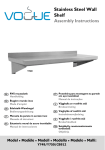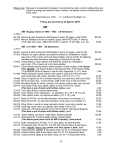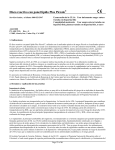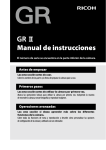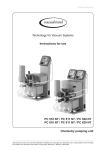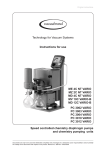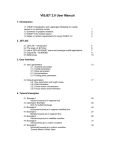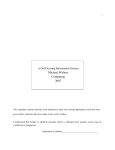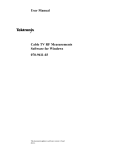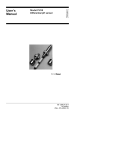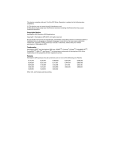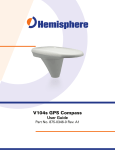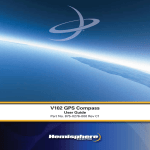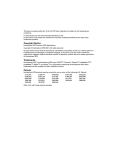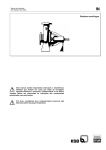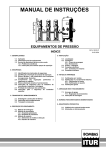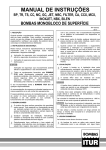Download EVITA® OXY
Transcript
DOC023.52.00076.Jun05 EVITA® OXY User Manual © HACH LANGE GmbH, 2005. All rights reserved. Printed in Germany Contents Introduction.......................................................... 2 Mechanical installation ....................................... 4 Transmitter ............................................................ 4 Assembly ............................................................... 6 OXY 4100 .............................................................. 8 OXY 4150/3150 ..................................................... 9 USC 5000/6000/7000 .......................................... 10 USC 6000/7000 19” version ................................ 11 Optional add-on module USC 6000/7000 ........... 12 Optional add-on module USC 6000/7000 19” version ........................................................... 13 Programming USC 5000/6000/7000 ................. 20 Keypad and display layout .................................. 20 Factory settings ................................................... 21 Menu structure .................................................... 22 USC 7000 multidrop system ................................ 25 Setting of oxygen/temperature units and transmitter’s current output .................................. 26 USC 5000/6000 current output settings .............. 27 USC 7000 current output settings ....................... 28 USC 6000 relay output settings ........................... 29 USC 7000 relay output settings ........................... 30 Troubleshooting ................................................ 40 Error system ....................................................... 40 Troubleshooting guide OXY 4100/3150/4150 stand alone transmitter .... 42 OXY 4100/3150/4150 transmitter ........................ 43 USC ..................................................................... 44 Technical Data ................................................... 48 Transmitter .......................................................... 48 USC ..................................................................... 50 HART® ................................................................. 52 Calibration .......................................................... 31 Electrical installation ........................................ 14 OXY 4100/4150/3150 stand alone transmitter .... 14 USC 5000/6000 and OXY 4100/4150 point to point ........................................................ 16 USC 7000 and OXY 4100/4150 multidrop........... 17 Initial start up ..................................................... 18 OXY 4100/4150/3150 stand alone transmitter .... 18 System with USC 5000/6000/7000 ..................... 19 Appendix I .......................................................... 53 Maintenance ...................................................... 33 Appendix IIa ....................................................... 54 Other Settings .................................................... 34 System information .............................................. 35 Forced current and relay outputs ........................ 38 Appendix IIb ....................................................... 55 Warranty, liability and complaints.................... 56 Contacts ............................................................. 57 1 2 Introduction EVITA® OXY sensors are used for measuring the concentration of dissolved oxygen in water – especially in controlling and monitoring aeration processes in wastewater treatment plants, but also in applications such as fish frarms. OXY 1100 sensor EVITA® OXY consists of an OXY 1100 sensor, an OXY 4100 transmitter and a USC Universal Signal Converter. USC 5000 IP 67 (NEMA 4X) There are two versions of the transmitter – a ball float version, OXY 4100, and a probe version, OXY 4150/3150. The operating principle is identical for both versions. OXY 4100 transmitter There are three versions of the USC - a USC 5000 basic version, and a USC 6000 with added features, both point to point. A USC 7000 with HART® multidrop functionality enabling up to 15 transmitters on only two wires. USC 6000/7000 IP 67 (NEMA 4X) The EVITA® OXY 1100 sensor is the heart of the oxygen meter. The transmitter converts the measurements by the sensor into a current signal and at the same time also performs the necessary calculations/corrections. The signal converter is the display and programming unit and offers additional outputs. Documentation needs to be consulted. OXY 4150/3150 transmitter The user shall be made aware of that, if the equipment is used in a manner not specified by the manufacturer, the protection provided by the equipment may be impaired. USC 6000/7000 19” The EVITA® OXY system offers several advantages: 2-wire transmitter – simple and fast installation Easy maintenance – simple automatic calibration in atmospheric air initiated by using the TILTCAL® or the USC 5000/6000/7000 – – self-cleaning ball float simple sensor replacement after 2-3 years High reliability – – – self-diagnosing membrane leakage detection fault indication on transmitter current output Flexible communication – HART® communication as standard gives added features setting of measuring range and units from a distance display of dissolved oxygen and temperature, remaining OXY 1100 sensor life and specific event codes – Option module can be fitted in the USC 6000/7000 without the need for tools 3 4 Mechanical installation Transmitter Mounting on a handrail The mounting bracket for OXY 4100 and 4150 can be mounted directly on a handrail using the supplied hose clips. Retighten the hose clips after a few days use to ensure a tight mounting of the mounting bracket. In case of strong sideways forces, the PVC pipe should be mounted with supporting wires. This takes up some of the sideways mechanical forces on the pipe and avoids cracking of the mounting bracket. (m ax .1 4 ’) vmin.= 0.05 m/s (2”/sec). Fig. 1 Fig. 2 Mounting on a concrete wall Pipe mounting The mounting bracket for OXY 4100 and 4150 can be mounted directly on to a concrete wall using 2 screws AISI 316 (diameter max. 10 mm or 3/8 UN). The OXY 4150 transmitter can be mounted in a PVC pipe as shown in fig. 4. Mounting of OXY 4150 transmitter using cable bracket The strength of the transmitter cable is such that the transmitter can be allowed to hang from it. Bracket (A) is available as accessory supplied by HACH LANGE. However, (B) is not. B or 3/8 UN A Fig. 3 Fig. 4 Fig. 5 5 6 Assembly Ball float assembly Mount the single parts as shown in fig. 6. E Q D Q C Q A: OXY 4100; 1 1/4” pipe thread B: is supplied with transmitter B C: 45° PVC or ABS elbow; inside diameter: 50 mm or 1 1/2”; supplied by customer D: PVC or ABS tube; 50 mm or 1 1/2”; supplied by customer A E: 90° PVC or ABS elbow; inside diameter: 50 mm or 1 1/2”; supplied by customer Q: PVC or ABS adhesive; supplied by customer Fig. 6 Probe assembly Mount the single parts as shown in fig. 6a. F Q E Q D Q C A: OXY 4150/3150; diameter 50 mm B: adaptor with 11/4” pipe thread (085G3325) or union with diameter 50 mm (081B0028); is supplied with system packages 1A and 2A B C: adaptor with 1½” and 50 mm outside diameter (081B0027); is supplied with system packages 1A and 2A A D: PVC or ABS socket; inside diameter: 50 mm or 1½”; supplied by customer E: PVC or ABS tube; 50 mm or 1½”; supplied by customer Fig. 6a F: 90° PVC or ABS elbow; inside diameter: 50 mm or 1½”; supplied by customer Q: PVC or ABS adhesive; supplied by customer 7 8 OXY 4100 Mounting and replacement of OXY 1100 sensor Mount the sensor on the ball float as shown in fig. 7. At mark 5: Turn until a “click” is heard. Fig. 7 OXY 4150/3150 Mounting and replacement of OXY 1100 sensor Mount the sensor on the probe as shown in fig. 8. At mark 5: Turn until a “click” is heard. Fig. 8 9 10 USC 5000/6000/7000 Mounting on a handrail Mounting on a concrete wall Mount the bracket on a vertical or horizontal pipe using the two stainless steel hose clips. Mount the bracket on to a wall using four screws (diameter max. 8 mm or 5/16 UN). Fig. 10 Fig. 9 Fig. 11 Fig. 12 USC 6000/7000 19” version Mounting in panel First mount the terminal board in the front panel IP 65 (NEMA 4X) enclosure, figs. 13 and 14, or the back of the panel bracket, fig. 15. Plug in the 19” USC 6000/7000 signal converter in the enclosure or bracket using the four small screws to tigthen it. Fig. 13 Fig. 14 Fig. 15 11 12 Optional add-on module USC 6000/7000 Unpack the add-on module and locate it in the bottom of the signal converter as shown in fig. 16. Press the add-on module forward as far as possible. See fig. 17. Avoid touching the pc board and the sockets. The add-on module has now been installed and the signal converter is ready to be installed on the terminal box. The menus related to the optional add-on module will automatically become visible and electrical inputs and outputs are automatically established by power on. Fig. 16 Fig. 17 Fig. 18 Optional add-on module USC 6000/7000 19” version Unpack the add-on module and locate it in the bottom of the signal converter as shown in fig. 19. Press the add-on module forward as far as possible. See fig. 20. Avoid touching the pc board and the sockets. The add-on module has now been installed and the signal converter is ready to be installed on the terminal box. The menus related to the optional add-on module will automatically become visible and electrical inputs and outputs are automatically established by power on. Fig. 19 Fig. 20 Fig. 21 13 14 Electrical installation OXY 4100/4150/3150 stand alone transmitter The transmitter is connected using the two-wire, shielded cable. The two leads carry supply voltage, a 4-20 mA current signal, and HART® communication. + If the cable is extended, the total length of the cable must not exceed 1000 m (3000’). Always use twowire, shielded cable for the extension (min. 2 x 0.2 mm2 (24 AWG)). – Red Shield Examples of coupling to loop-powered display and PLC/SCADA system are shown in fig. 22, fig. 23 and fig. 24, respectively. A suitable power supply shall be considered in the end-use application. The power supply must be a Class 2 power source (limited circuit) according to the National Electrical Code (NEC) and provided double/reinforced insulation between mains and the 12-30 V d.c. supply for the oxygen transmitter. Black EVITA® OXY connected to loop-powered display. Fig. 22 Note: Components like motors, pumps and computers may cause high voltage potential differences between the protective earth/ ground wire and the water in the tank, that results in unstable readings. If this problem occurs, mount an earthing electrode in the tank to equalise the electrical potential of the water to PE. If the flow velocity in the tank is high, it may cause a static potential locally. Is this the case, mount the earthing electrode close to the transmitter. Red Black Shield Black Red Shield EVITA® OXY supplied from PLC/SCADA system. Fig. 23 Fig. 24 EVITA® OXY connected to a PLC/SCADA system with external power supply. 15 16 USC 5000/6000 and OXY 4100/4150 point to point The transmitter is connected using the two-wire, shielded cable. The two leads carry supply voltage, a 4-20 mA current signal and HART® communication. USC 5000/6000 - IP 67 version If the cable is extended, the total length of the cable must not exceed 1000 m (3000’). Always use twowire, shielded cable for the extension (min. 2 x 0.2 mm2 (24 AWG)). On the USC signal converter it is possible to disable the function of the digital input (used for calibration control on the EVITA INSITU 4100 transmitter). Depending on the USC version the power supply should be connected to terminals L, N and PE when using 100-240 V a.c., or to terminals 1 and 2 when using 24 V a.c./d.c., see fig. 25 and fig. 26. Note: The digital input is available on both USC 5000, USC 6000 and USC 7000. USC 6000 - 19” version Fig. 26 USC Shield Input Relay 3 Black Red Relay 2 Relay 1 Shield I out 1 Relay 3* Black USC DIG IN Digital input Function On I out 2 Relay 2* On Off Red Relay 1* 081R9433.02.01 I out 1 I out 2* Digital input Digital input Fig. 25 *Only USC 6000 Fig. 25a USC 7000 and OXY 4100/4150 multidrop The USC 7000 is able to communicate with up to 15 EVITA® OXY transmitters using HART® multidrop protocol on only two wires. Each transmitter should be connected in parallel outside the USC connection box and only two wires with shield mounted on the terminals in the USC 7000. Note: Components like motors, pumps and computers may cause high voltage potential differences between the protective earth/ ground wire and the water in the tank, that results in unstable readings. If this problem occurs, mount an earthing electrode in the tank to equalise the electrical potential of the water to PE. If the flow velocity in the tank is high, it may cause a static potential locally. Is this the case, mount the earthing electrode close to the transmitter. Relay 5 Important: The below mentioned warnings concern both USC 5000, USC 6000 and USC 7000. The HART communication terminals (84/85) and the Digital Input terminals (77/78) of the Universal Signal Converter must not be connected to external voltage level above 30 V d.c. The Relay terminals (40-49) of the Universal Signal Converter must not be connected to external voltage level exceeding 48 V d.c., 30 V rms or 42 V peak. Protective conductor terminal. Required cable min. AWG16 or 1.5 mm2 Cu. Relay 4 Shield Relay 3 Relay 2 Black Red Relay 1 I out 1 I out 2 I out 3 I out 4 Digital input Fig. 27 Field wiring installation of the Universal Signal Converter must be in accordance with the National Electrical Code. Mains supply 100 to 240 V a.c. from building installation (Overvoltage category II). A switch or circuit-breaker (max. 15 A) shall be included in the building installation. The switch/circuitbreaker shall comply with relevant requirements of IEC 947-1 and 947-3. It must be in close proximity to the equipment and within easy reach of the operator, and it shall be marked as the disconnecting device for the equipment. 17 18 Initial start up OXY 4100/4150/3150 stand alone transmitter 1. Apply voltage with the OXY 1100 sensor pointing upwards in free air for 2 minutes. This will zero the sensor life counter. The life counter can be read via the signal converter (USC) or HART® communication. Fig. 28 2. Place the transmitter so that the OXY 1100 sensor points downwards, still in free air. Leave it in this position for 1 hour to allow the sensor to stabilise. Fig. 29 3. Calibrate in accordance with the instructions in the “Calibration” section p. 31. System with USC 5000/6000/7000 1. Place the transmitter in free air so that the OXY 1100 sensor points downwards, see fig. 30. 2. Turn on the power to the signal converter USC 5000/6000/7000. 4. Check factory settings, see p. 21. Change if necessary. 3. Leave the transmitter in this position for at least 1 hour to allow the sensor to stabilise before calibrating. 5. Reset the lifetime counter, see fig. 32, p. 22. 6. Calibrate in accordance with the instructions in the “Calibration” section, p. 31. 7. After calibration is completed, place the transmitter in the measuring media. Fig. 30 19 20 Programming USC 5000/6000/7000 Keypad and display layout Fig. 31 TOP UP KEY (ESC) This key (hold for 2 sec.) is used to switch between the operator menu and setup menu. A short press will cause a return to the overlying menu. FORWARD KEY This key is used to step forward through the menus in the setup menu. BACKWARD KEY This key is used to step backward through the menus. CHANGE KEY This key changes the settings or numerical values in the setup menu. In the operator menu it is used to step through the menues. SELECT KEY This key selects which digits to be changed. LOCK/UNLOCK KEY (ENTER) This key allows the operator to change settings and gives access to submenus. Various display symbols Ready for change Value locked Access to submenu Confirmation of choice The keypad is used to set the EVITA® OXY and to step through the menus. The function of the keys are as follows: IMPORTANT: The USC starts up showing the menu “Language” in English. Press the key until the wanted language appears in the display and press the key. After the language is chosen, the USC will show “Concentration” in the operator menu (see p. 22). The factory setting of the language can be reestablished as follows: • Switch off the power supply • Press the supply • Release the key and switch on the power key after 10 seconds The language is now reset to English. Factory settings The EVITA® OXY system is supplied with the following factory settings: Parameter Factory settings Options Current output 1 (System packages 1 and 2) 0-20 mg/l Range: USC 5000/6000/7000 Span: Current output 2 (System package 1) Range: Span: min. -10°C max. 70°C min. 1°C Current outputs USC 5000/6000/7000 OFF OFF ON Relays 1, 2 and 3 (USC 6000) OFF Alarm; Warning; Limit; Timer; OFF Relays 1, 2, 3, 4 and 5 (USC 7000) OFF Alarm; Warning; Limit; Timer; OFF Enabled Enabled; Disabled Password 1000 1000-9999 Oxygen unit mg/l mg/l; ppm; % Temperature unit °C °C; °F Current output when not measuring Low High; Low; Hold Current output during error Low High; Low; Normal Time constant 40 sec. 10-300 sec. TILTCAL OXY 4100/4150 0-40 °C min. 0 mg/l or ppm; 0% max. 50 mg/l or ppm; 500% min. 1 mg/l or ppm; 10% ® If factory settings are satisfactory, proceed to p. 31. 21 22 Menu structure Fig. 32 12.31 mg/l Oxygen Transmitter 0 7.09 mg/l Oxygen Transmitter 1 2.51 mg/l Oxygen Transmitter 2 6.22 mg/l Oxygen Transmitter 15 Error pending Scan HART bus Operator menu The operator menu is for daily use. After the language has been selected, the signal converter starts up in the operator menu showing the actual concentration of dissolved oxygen. 18.5°C Temperature Transmitter 0 0 Calibration Transmitter 0 No. of alarms Transmitter 0 Calibration Transmitter 1 No. of alarms Transmitter 1 Calibration Transmitter 2 No. of alarms Transmitter 2 Calibration Transmitter 15 No. of alarms Transmitter 15 0 18.5°C Temperature Transmitter 1 18.5°C Temperature Transmitter 2 0 18.5°C Temperature Transmitter 15 0 The USC 5000/6000 is point-to-point installation while the USC 7000 is for a multidrop system. In fig. 32 menus marked with grey are only visible in the multidrop system. It is possible to hide some of the menus in the operator menu, see fig. 43, p. 34. 50.% Rem. Lifetime Transmitter 0 72. d Reset lifetime Transmitter 0 Last calibration Transmitter 0 Reset lifetime Transmitter 1 Last calibration Transmitter 1 Reset lifetimes Transmitter 2 Last calibration Transmitter 2 Reset lifetime Transmitter 15 Last calibration Transmitter 15 85.% Rem. Lifetime Transmitter 1 26. d 70.% Rem. Lifetime Transmitter 2 84. d 95.% Rem. Lifetime Transmitter 15 71. d 081R9301.02.01 The menu of the signal converter is built up in two parts. An operator menu and a setup menu. Setup menu The setup menu is shown in an overview diagram (fig. 33) on page 24. • View mode is a read only mode. The preselected settings can only be scanned. The view mode is accessed by pressing the key for 2 seconds. Instead of keying in the password, press the key. The factory setting of the password can be reestablished as follows: • Switch off the power supply • Press the The setup menu consists of two parts: • USC setup menu - for USC settings • Transmitter setup menu - for transmitter settings The setup menu is for commissioning and service and for changing the settings. Access to the setup menu is gained by pressing the key for 2 seconds. The setup menu will operate in two modes: • Setup mode is a read and write mode. The preselected settings can be scanned and changed. The setup menu is accessed by pressing the key for 2 seconds and entering the password. The factory set password is 1000, but can be changed to any value between 1000 and 9999. • Release the key and switch on the power supply key after 10 seconds The password is now reset to 1000. 23 24 Fig. 33 USC USC USC Output Input Reset mode USC USC USC Service mode Product identity HART Settings ~ USC Settings 10.64 mg/l ~ Password 0000. USC USC USC Operator menu setup Password Language Temperature Transmitter 0 42. d Calibration Transmitter 0 USC USC USC USC USC USC USC I out 1-4 Digital input Set default setting I Out 1-4 Type USC5000 Change HART Trm. Mode OXY 12. d No. of alarms Transmitter 0 Relay 1-5 72. h Relay 1-5 Rem. lifetime Transmitter 0 Digital input Event log Reset lifetime Transmitter 0 HART comm. error 10.64 mg/l Oxygen Transmitter 0 42. d Calibration Transmitter 0 TR. 0 TR. 0 TR. 0 TR. 0 TR. 0 Settings OXY Ser.No. SSSSVVNUUÅ Basic settings Advanced settings Send command Info 12. d No. of alarms Transmitter 0 72. h Rem. lifetime Transmitter 0 Reset lifetime Transmitter 0 Last calibration Transmitter 0 TR. 0 TR. 0 TR. 0 TR. 0 Oxygen unit ppm Set transmitter address 00 Calibration Time since last calibr. Value at 4 mA Value at 20 mA Temp. unit Error pending Serial no. SW version HW version Further info. Last calibration Transmitter 0 Temperature Transmitter 0 Code no. Calibr. type After calibration TILTCAL Start measuring Reset lifetime Set factory settings Error pending Event log TILTCAL Sensor type Transmitter mode Salinity Manufacturer Id. Rel. humidity Output when not measuring Output during error Time constant Mfr. device type Univ. cmd. rev. Transm. cmd. rev. SW version Scan HART bus HW version Device id. Scan HART bus 081R9418.02.02 Oxygen Transmitter 0 USC 7000 multidrop system Changing transmitter address from default To allow the USC 7000 to recognise the transmitter on the HART® bus, the transmitter needs a unique address between 1 and 15. The EVITA® OXY transmitter is factory delivered with the address 0, which is used for point-to-point installations (USC 5000/6000). To programme the address of a new transmitter, connect the transmitter to the USC 7000 and press “Scan HART bus”. The transmitter will get the next available address between 1 and 15. Note: If, before scanning the HART® bus, a transmitter with address higher than 0 was registered as interrupted, the new transmitter will be assigned this address. 081R9302.02.02 Password 0000. USC Settings 10.64 mg/l Oxygen Transmitter 0 Temperature Transmitter 0 42. d Calibration Transmitter 0 12. d No. of alarms Transmitter 0 72. h TR. 0 TR. 0 TR. 0 Settings OXY Ser.No. SSSSVVNUUÅ Basic settings Advanced settings Rem. lifetime Transmitter 0 Reset lifetime Transmitter 0 TR. 0 Set transmitter address 00 Last calibration Transmitter 0 Error pending Scan HART bus USC USC USC Scan HART bus Are you sure ? Scan HART bus Busy Trm. address 0 changed to 05 Fig. 34 25 26 Setting of oxygen/temperature units and transmitter’s current output If other settings are wanted, the factory settings can be changed as shown below. Fig. 35 Setting of the displays and current outputs units for oxygen and temperature can be done in “Basic settings”. Setting of the transmitter’s measuring range for oxygen can be done by changing the value at 4 mA and the value at 20 mA. However the setting of current outputs range for oxygen and temperature is done as shown in fig. 36, p. 27 and fig. 37, p. 28. USC 5000/6000 current output settings Setting of current output 1 on USC 5000 and current outputs 1 and 2 on USC 6000. Fig. 36 USC Output ** USC USC I out 1 I out 2 * Units selected in “Transmitter basic settings“, see fig. 35, p. 26. ** Only USC 6000 Same as I out 1 I OUT 1 Function Off On Off I OUT 1 I OUT 1 Value pH Value at 4 mA +000.00 mg/l Value at 20 mA +999.00 mg/l Range: 0-999 Range: 0-999 pH Temperature I OUT 1 081R9412.02.01 Value at 4 mA +000.00 °C Range: -10 - 999 * * I OUT 1 I OUT 1 * * I OUT 1 I OUT 1 I OUT 1 Output when not measuring 20 mA Output during error Normal Time const. 040. s 20 mA 4 mA Hold Normal 23 mA 3.8 mA Normal 030-300s Value at 20 mA +999.00 °C Range: -10 - 999 27 28 USC 7000 current output settings Setting of current outputs 1 to 4 on USC 7000. USC Output USC USC USC USC I out 1 I out 2 I out 3 I out 4 Same as I out 1 Same as I out 1 * Units selected in “Transmitter basic settings”, see fig. 35, p. 26. Same as I out 1 I OUT 1 Function Off On Off * I OUT 1 I OUT 1 I OUT 1 Select transmitter 00 Value Oxygen Value at 4 mA +00.00 mg/l Value at 20 mA +999.00 mg/l Range: 0-999 Range: 0-999 00-15 I OUT 1 * Oxygen Temperature 081R9413.02.01 Fig. 37 I OUT 1 Value at 4 mA +000.00 °C Range: -10 - 999 * I OUT 1 Value at 20 mA +999.00 °C Range: -10 - 999 * I OUT 1 I OUT 1 I OUT 1 Output when not measuring 20 mA Output during error Normal Time const. 040. s 20 mA 4 mA Hold Normal 23 mA 3.8 mA Normal 030-300s USC 6000 relay output settings * ** Setting of relay outputs 1 to 3 on USC 6000. 081R9414.02.02 USC USC ~ Output I out 1 Units selected in “Transmitter basic settings” fig. 35, p. 26 To allow the current output to stabilise after a cleaning, the USC locks the current output during “Cleaning time” and additional 10 minutes. USC USC USC Relay 1 Relay 2 Relay 3 Same as Relay 1 Same as Relay 1 RELAY 1 Relay at error Open RELAY 1 Function Off On Timer Off Open/Closed RELAY 1 RELAY 1 Function Error Error Warning Hi Limit Lo Limit Cleaning Relay at warning Open Open/Closed RELAY 1 * RELAY 1 RELAY 1 RELAY 1 Value Oxygen Setpoint 050.00 mg/l Hysteresis 005.00 mg/l Relay above limit Open Oxygen Temperature 0 - 999.99 0 - 999.99 Open/Closed RELAY 1 * * RELAY 1 Setpoint 035.00 ºC Hysteresis 005.00 ºC 0 - 999.99 0 - 999.99 * RELAY 1 Same as Hi Limit Relay below limit Open Open/Closed Fig. 38 ** RELAY 1 RELAY 1 RELAY 1 Cleaning interval 000. h Cleaning time 00 min Relay at cleaning Open 1-999 h 1-59 min Open/Closed RELAY 1 RELAY 1 RELAY 1 Timer interval 000. h Active time 00 min Relay at active Open 1-999 hours 1-59 min Open/Closed 29 30 USC 7000 relay output settings * ** Setting of relay outputs 1 to 5 on USC 7000 Units selected in “Transmitter basic setting”, fig. 35, p. 26. To allow the current output to stabilise after a cleaning, the USC locks the current output during “Cleaning time” and additional 10 minutes. USC USC USC USC USC USC Relay 1 Relay 2 Relay 3 Relay 4 Relay 5 Same as Relay 1 Same as Relay 1 Same as Relay 1 081R9415.02.02 USC I out 1 ~ Output RELAY 1 Same as Relay 1 Relay at error Open Open/Closed RELAY 1 Relay at warning Open Open/Closed RELAY 1 Function Off One transmitter All Errors All Warnings Timer Off RELAY 1 RELAY 1 Select transmitter no. 00 00-15 Function Error Error Warning Hi Limit Lo Limit Cleaning RELAY 1 RELAY 1 Value Oxygen Setpoint 050.00 mg/l 0 - 999.99 Oxygen Temperature RELAY 1 * RELAY 1 * * Setpoint 035.00 ºC 0 - 999.99 RELAY 1 RELAY 1 Relay above limit Open Open/Closed Hysteresis 005.00 mg/l 0 - 999.99 * Hysteresis 005.00 ºC 0 - 999.99 RELAY 1 Same as Hi Limit Relay below limit Open Open/Closed ** RELAY 1 RELAY 1 RELAY 1 Cleaning interval 000. h Cleaning time 00 min Relay at cleaning Open 1-999 h 1-59 min Open/Closed RELAY 1 Relay at Error Open Open/Closed RELAY 1 Relay at warning Open Open/Closed Fig. 39 RELAY 1 RELAY 1 RELAY 1 Timer interval 000. h 1-999 hours Active time 00 min 1-59 min Relay at active Open Open/Closed Calibration EVITA® OXY sensors must be calibrated in atmospheric air. Calibration every 6 months is recommended. Calibration can be initiated from the USC 5000/6000/7000 or by using the TILTCAL® feature in the OXY transmitter. During calibration, the OXY 1100 sensor must not be exposed to direct sunlight. Before calibration, the OXY 1100 sensor must be cleaned, see section “Maintenance”. With fast calibration in atmospheric air a 1% system accuracy can be obtained. Temperature and barometric pressure compensation is made automatically during calibration via an internal temperature and pressure sensor. Using TILTCAL® Hold the transmitter with the OXY 1100 sensor upwards to initiate calibration by activating the tilt switch. After 5 min. turn the transmitter with the OXY 1100 sensor downwards and the transmitter has completed the calibration routine. During calibration, the current output signal is factory set to 4 mA. Optional 20 mA or the last measured value (Hold) can be chosen via the USC 5000/6000/7000. TILTCAL® Fig. 40 Tilted Not tilted 31 32 If during the 5 minutes calibration period the transmitter is turned with the OXY 1100 sensor downwards, calibration stops and measurements continue with the previous calibration value. Temperature compensation is made automatically during calibration via an internal temperature sensor. In addition, using factory settings, compensation is also made for air pressure, relative humidity and salinity. These factory-set values can be changed via the USC signal converter or via HART® communication. Using the USC 5000/6000/7000 In operator menu use the key to select the “Calibration” menu and press the key to initiate a calibration. Compensations for relative humidity and salinity can be made by entering these values using the USC 5000/6000/7000, see fig. 48, p. 37. The set values and the significance of deviations from them are given in appendix I. A system accuracy of 0.5 % can be achieved by lifting the transmitter out of the medium and placing it with the OXY 1100 sensor downwards for 1 hour to make sure the sensor is completely stabilised. Calibration can then be initiated. * See “Advanced settings, fig. 48, p. 37. USC 5000/6000/7000 calibration Fig. 41 Maintenance Under normal conditions, the OXY 1100 sensor will operate for 2-3 years and can be replaced in a few minutes. General maintenance of the EVITA® OXY sensor is limited to cleaning about every 2-3 months and calibration about every 6 months. Cleaning (OXY transmitter) During cleaning, the sensor must not be allowed to remain pointing upwards for more than 3 minutes at a time if the TILTCAL® function is enabled, otherwise a calibration cycle will start. The TILTCAL® function can be disabled according to fig. 48, p. 37. 1. Lift the transmitter out of the medium. 2. Clean the sensor with pure water, to which a little cleaning agent/washing-up liquid can be added. 3. Dry the sensor with a soft cloth. 4. Immerse the transmitter into the medium to be measured. Cleaning (USC signal converter) When considered necessary, clean the USC signal converter using a soft moist cloth. Replacement of sensor 1. Remove the defective/worn sensor. 2. Insert new sensor (see fig. 7, p.8 or fig. 8, p. 9). 3. Reset the lifetime counter (see p. 18 or fig. 32, p. 22). 4. Place the transmitter so that the OXY 1100 sensor points downwards. Keep it in this position for at least 1 hour to allow the new sensor to stabilise (see fig. 29, p. 18). 5. Perform calibration (see section “Calibration” p. 31-32). Fig. 42 33 34 Other Settings In the “Operator menu setup” it is possible to hide all menus except “Oxygen” in the operator menu. • A in the operator menu setup means that this reading is shown in the operator menu. Fig. 43 • A in the operator menu setup means that this reading is not available when viewing the operator menu. System information Transmitter information In the menu “Info” it is possible to view various information about the transmitter, e.g. time since last calibration, transmitter mode and software and hardware versions. Fig. 44 USC information In the menu “Product identity” it is possibel to read the USC type (5000/6000/7000) and the serial number. Fig. 45 35 36 Reset mode The factory settings can be re-established as shown in fig. 46. Fig. 46 Send command In the “Send command” menu it is possible to start calibration, to start measuring after calibration, to reset lifetime and to set factory settings. See fig. 41, p. 32 Fig. 47 Advanced settings In the “Advanced settings” menu it is possible to choose which calibration type to be used and which type of start after calibration. Furthermore factors for compensation for salinity and relative humidity can be keyed in. “Automatic calibration” means calibration in atmospheric air and “Manual calibration” means calibration in a standard solution where the concentration of oxygen is keyed in, see fig. 41, p. 32. “Transmitter address” has to be 0 for current output to function in a point-to-point installation using USC 5000 or 6000. When operating in multidrop system using USC 7000, the transmitter must have a unique address between 1 and 15. TR. 0 TR. 0 TR. 0 TR. 0 TR. 0 TR. 0 TR. 0 Advanced settings Set transmitter address 00 Calibr. type Manual After calibration Automatic start TILTCAL Enabled Mem leakage detect Enabled Sensor type 50 um 00-15 Manual Automatic Manual start Automatic start Enabled Disabled Enabled Disabled 25 50 125 um TR. 0 TR. 0 TR. 0 TR. 0 TR. 0 Salinity 040. g/l Rel. humidity 060. % Output when not measuring Low Output during error Low Time const. 040. s 0-40 g/l 0-100 % High Low Hold High Low Normal 10-300 s Fig. 48 37 38 USC USC USC USC USC Service mode I Out 1 I Out 2 I Out 3 I Out 4 081R9406.02.02 Forced current and relay outputs I OUT 1 Service mode Mode Normal In the “service mode” it is possible to control the relay and the current outputs directly. This may be useful when e.g. a control loop is to be adjusted or if an alarm signal should be checked. Normal Forced The quality of the HART® communication is displayed in the “HART comm. error” submenu. The quality is shown as: VVVV XXXX YYY % ZZ I OUT 1 Forced value 00.0 mA 00.0-24.0 mA USC USC USC USC USC Relay 1 Relay 2 Relay 3 Relay 4 Relay 5 RELAY 1 Mode Normal where VVVV is the number of received messages without any errors, XXXX is the number of received messages with errors, YYY % is the percentage of messages that had errors ZZ is the number of messages that were eliminated, i.e. max. number of retries was reached. Fig. 49 Normal Open Closed USC USC USC Digital input High Event log HART comm. error 0856 0007 001% 00 (High/Low) USC Log xxxxdxxh xxxxxxxxxxxxxxxx 39 40 Troubleshooting Error system The EVITA® OXY has an advanced self-diagnostic system. If there is an error or a warning, a flashing bell is displayed. To view the pending error information, press the key in the operator menu – see below. Operator menu Fig. 50 The USC and the transmitter each has an ‘event log’ that stores past errors, information and warnings. To access the USC event log, see fig. 49, p. 38. To see the transmitter event log, see fig. 44, p. 35. Each event has an unambiguous identification consisting of 4 digits: E O 5 5 EO55: The OXY 1100 diaphragm has been damaged. 1. digit: Category I(Information); W(Warning); E(Error) 2. digit: Sensor type U for USC O for OXY I for INSITU 4100 N for INSITU 5100 P for PH/REDOX S for TSS 3. and 4. digit: Error number 00-99 The numbers are describing the following events: 0-9 Information 10-49 Warning 50-99 Error Information The system will continue to measure as usual. Relay and output signals will not be affected. Warning The system will continue to measure, but there has been an event, which may cause malfunction of the system, and which may require an operator. The reason for the warning may disappear on its own. Warning relay, if defined, will show warning in accordance with the setup. Error The whole system or parts of it is malfunctioning, and the output signal is not reliable anymore. The errors require an operator. Error relays, if defined, will show error in accordance with the setup. The EVITA® OXY transmitter error pending list shows the 5 latest occured errors that are still pending, and the event log shows the 25 latest events, i.e. informations, warnings and errors. The USC signal converter error pending list can show up to 14 pending errors and warnings, displayed with the USC errors first and then the transmitter errors. If there are more than 14 pending errors, the message “Additional errors cannot be viewed” will show in the display. The USC event log shows the 9 latest events. 41 42 Troubleshooting guide - OXY 4100/3150/4150 stand alone transmitter Symptom Current signal Fault Remedy Constant current signal (varying oxygen concentration) I = 0 mA Incorrect wiring Check wiring and make the necessary corrections. Undervoltage Check the supply voltage at transmitter. Supply voltage must be at least 12 V. Initialisation fault 1. Switch off transmitter for min. 5 seconds. 2. Switch on again while sensor points downwards. Transmitter defective Replace transmitter Initialisation fault 1. Switch off transmitter for min. 5 seconds. 2. Switch on again while sensor points downwards. Transmitter defective Replace transmitter I = 3.85 mA or 23.5 mA Membrane leakage Replace OXY 1100 sensor. Moisture behind OXY 1100 sensor Fully dry the terminals at transmitter. A hair dryer might be of assistance. I = 3.90 mA or 23.0 mA Calibration not possible, worn OXY 1100 sensor Replace OXY 1100 sensor. I = 3.95 mA Oxygen under set measuring range Set the lower measuring limit to a lower value. I = 22.00 mA Oxygen level higher than set measuring range Set the upper measuring limit to a higher value. Variable Calibration value incorrect 1. Check FSO in atmospheric air. Hold the transmitter up in the air with the sensor downwards. Check value against DS/EN 25814 (see appendix IIa) 2. Check zero point (see appendix IIb) 3. In the case of large reading error, recalibrate. I = 3.80 mA or 24.0 mA Error in measuring value OXY 4100/3150/4150 transmitter Symptom Current output signal Error in measuring value Variable Event code Cause Remedy Calibration value incorrect 1. Check FSO in atmospheric air. Hold the transmitter up in the air with the sensor downwards. Check the value against DS/EN 25814 (see appendix IIa) 2. Check zero point (see appendix IIb) 3. In the case of large reading error, recalibrate End of calibration phase Go to “Send command” menu and start measuring, see fig. 47, p. 36 WO10 The measured value has exceeded the transmitter output setting Change upper range in “Basic settings”, see fig. 35, p. 26 WO11 The measured value is below the transmitter output setting Change lower range in “Basic settings”, see fig. 35, p. 26 WO15 Life time expired. OXY 1100 should be replaced as soon as possible Replace OXY 1100 WO20 The temperature of OXY 1100 is below 0°C (32°F). The accuracy might be reduced. Accuracy reduced WO21 The temperature of OXY 1100 is above 40°C (104°F). The accuracy might be reduced. Accuracy reduced EO50 Calibration not possible. OXY 1100 is worn or defective Replace OXY 1100 EO51 Output signal from OXY 1100 is too low. OXY 1100 is worn or defective Replace OXY 1100 EO55 The OXY 1100 membrane has been damaged Replace OXY 1100 EO60 Error in EEPROM Replace transmitter EO61 Error in communication between the µ-controller and the A/D converter or error in the A/D converter Replace transmitter EO62 Error in the input circuit Replace transmitter EO63 Error in the temperature circuit Replace transmitter Display switching between “Oxygen” and “End of calibration” Flashing bell in display Depending on the settings 43 44 USC Symptom Current output Event code Cause Remedy None Undefined IU00 Power on Registration of time of power on IU01 Add-on module applied Registration of applied add-on module IU02 Add-on module defective or removed Replace or install add-on module IU03 Parameter successfully corrected Information 1. Supply voltage 2. USC 5000/6000/7000 defective 1. Check supply voltage 2. Replace USC 5000/6000/7000 Same as EU61 p. 45 Empty display Dots in upper line of display Flashing bell in display (I out 1) EU61 See EU61 p. 45 (I out 2) EU62 See EU62 p. 45 (I out 3) EU63 See EU63 p. 45 (I out 4) EU64 See EU64 p. 45 Undefined WU10 I out 1: Value at 4 mA >= Value at 20 mA Check I out 1 setup WU11 I out 2: Value at 4 mA >= Value at 20 mA Check I out 2 setup WU12 I out 3: Value at 4 mA >= Value at 20 mA Check I out 3 setup WU13 I out 4: Value at 4 mA >= Value at 20 mA Check I out 4 setup WU14 The measured value has exceeded the current output 1 setting Change value at 20 mA on I out 1 WU15 The measured value has exceeded the current output 2 setting Change value at 20 mA on I out 2 WU16 The measured value has exceeded the current output 3 setting Change value at 20 mA on I out 3 WU17 The measured value has exceeded the current output 4 setting Change value at 20 mA on I out 4 WU18 The measured value is below the current output 1 setting Change value at 4 mA on I out 1 WU19 The measured value is below the current output 2 setting Change value at 4 mA on I out 2 WU20 The measured value is below the current output 3 setting Change value at 4 mA on I out 3 WU21 The measured value is below the current output 4 setting Change value at 4 mA on I out 4 Symptom Current output Event code Cause Remedy Flashing bell in display Undefined WU39 HART communication error Check cables WU40 TMS communication error Replace TMS WU41 A parameter is out of range. It could not be replaced by its default value Fixed at power-up WU43 Too many errors at the same time. Some errors are not registered correctly Power-up USC WU49 Internal error Power-up USC One or more current outputs = 3.8 mA or 24 mA EU60 CAN bus application does not respond. This error is shown when the maximum number of communication attempts is exceeded. 1. Power-up USC 2. Replace USC Undefined EU61 USC unable to read data required for I OUT 1 1. No reply from transmitter 2. Transmitter has got new address 3. Another master conflicts on HART® comm. 4. Supply voltage for transmitter too low 5. Too much noise on current loop 6. Transmitter defective 7. USC defective 1. Check shielding and cable connections 2. Power-up USC 3. Disconnect the other master or set USC to another master, see fig. 51, p. 52 4. Check supply voltage at transmitter, supply voltage must be at least 20 V 5. Check shielding and cable connections 6. Replace transmitter 7. Replace USC EU62 USC unable to read data required for I OUT 2 1 - 7: Same as EU61 Same as EU61 EU63 USC unable to read data required for I OUT 3 1 - 7: Same as EU61 Same as EU61 EU64 USC unable to read data required for I OUT 4 1 - 7: Same as EU61 Same as EU61 45 46 Symptom Current output Event code Cause Remedy Flashing bell in display Undefined EU65 USC unable to read data required for relay 1 1 - 7: Same as EU61 Same as EU61 EU66 USC unable to read data required for relay 2 1 - 7: Same as EU61 Same as EU61 EU67 USC unable to read data required for relay 3 1 - 7: Same as EU61 Same as EU61 EU68 USC unable to read data required for relay 4 1 - 7: Same as EU61 Same as EU61 EU69 USC unable to read data required for relay 5 1 - 7: Same as EU61 Same as EU61 47 48 Technical Data Transmitter Measurement Clark’s principle Transmitter cable Two-wire, screened cable 2 x 0.75 mm2 (18 AWG) cable, length 10 m (33’) Supply voltage Min. 12 Vd.c. - max. 30 Vd.c. HART®: max. ripple (47 Hz - 125 Hz): 0.2 V p-p max. noise (500 Hz - 10 kHz): 1.2 mV rms Power consumption Max. 720 mVA Current output 3.80-24 mA Time constant 10-300 s (default 40 s) Digital communication HART® communication superposed on current output Alarm signal On current output (see section “Trouble shooting”) Measuring range (can be configured) Transmitter: OXY 3150: OXY 4100/4150: Min. span: 4 - 50 ppm or mg/l; 40 - 500 % 0 - 50 ppm or mg/l; 0 - 500 % 1 ppm or mg/l; 10 % Sensor (recommended values to maintain operating life): OXY 1100, 25 µm: 0.002 - 2 ppm OXY 1100, 50 µm: 0.1 - 10 ppm OXY 1100, 125 µm: 2 - 50 ppm Temperature range Transmitter: Operation: Storage/transport: -40°C - +60°C (-40°F to 140°F) -40°C - +70°C (-40°F to 158°F) Sensor: Operation: Storage/transport: 0°C - +50°C (32°F to 122°F) 0°C - +70°C (32°F to 158°F) Measured media: 0°C - +40°C (32°F to 104°F) System accuracy Digital output: ±0.1 % of FSO at calibrating temperature Analogue output: ±0.2 % of FSO at calibrating temperature Digital/analogue output: ±0.5 % of FSO at 0 - 40°C (32°F to 104°F) Reaction time OXY 1100 25 µm: 50 µm: 125 µm: Diaphragm leakage monitoring Measurement between anode and a terminal in contact with the measured medium Enclosure OXY 4100: OXY 3150/4150: IEC 529: IP 68 (1 m); NEMA 6P (3’) IEC 529: IP 68 (10 m); NEMA 6P (30’) Dimensions and weight OXY 4100: OXY 3150/4150: d = 240 mm (9.6”); d = 50 mm; l = 180 mm (d = 2.0”; l = 7.2”); Materials PBT/PC EMC Emission: Immunity: τ = τ = τ = 7s 22 s 110 s 2.7 kg (6 lb) 1 kg (2.2 lb) IEC/EN 61000-6-3 IEC/EN 61000-6-2 The worn OXY 1100 sensor must be disposed as ordinary industrial waste, and the worn OXY 4100/4150 transmitter must be disposed as electronic waste. Before disposing the OXY 4100/4150, the cable must be cut off and disposed as metallic waste. Disposal in accordance with EU directive 2002/96/EC In compliance with EU directive 2002/96/EC, HACH LANGE / the local subsidiary will accept back and dispose of the old instrument at no cost. ATTENTION! It is not allowed to dispose of the instrument using municipal waste disposal services. Please talk to your local HACH LANGE contact. Important: Before returning goods to HACH LANGE, the products must be cleaned properly. 49 50 USC Type USC 5000 USC 6000 No. of transmitters 1 (point-to-point installation) 1 (point-to-point installation) 15 (multidrop) Measuring range Dissolved oxygen: Dissolved oxygen: Temperature: 0 to 10 – 500 % 0 to 0.1 – 50mg/l or ppm 0 – 70°C (32°F – 158°F) Dissolved oxygen: Temperature: 0 to 10 – 500 % 0 to 0.1 – 50mg/l or ppm 0 – 70°C (32°F – 158°F) Temperature: 0 to 10 – 500 % 0 to 0.1 – 50mg/l or ppm 0 – 70°C (32°F – 158°F) Measuring uncertainty Oxygen: Temperature: ± 0.5 % ± 0.5°C (0.9°F) Oxygen: Temperature: ± 0.5 % ± 0.5°C (0.9°F) Oxygen: Temperature: ± 0.5 % ± 0.5°C (0.9°F) Current outputs One 4-20 mA (scaleable), 24V active galvanic isolated Max. load: 800 ohm Two 4-20 mA (scaleable), 24V active galvanic isolated Max. load: 800 ohm Four 4-20 mA (scaleable), isolated 24V active galvanic Max. load: 800 ohm Relay outputs None 3 relay outputs SPST (max. 48 Va.c. or 30 Vrms 4 A) 5 relay outputs SPST (max. 48 Va.c. or 30 Vrms 4 A) Digital input Min. 12 to max 30 V d.c. (6 KOhm) Min. 12 to max 30 V d.c. (6 KOhm) Min. 12 to max 30 V d.c. (6 KOhm) Display Back-lit alphanumeric LCD display Back-lit alphanumeric LCD display Back-lit alphanumeric LCD display Enclosure IP 67 according to IEC 529; NEMA 4X IP 67, IP 20 according to IEC 529; NEMA 4X IP 67, IP 20 according to IEC 529; NEMA 4X Ambient temperature Storage: Operation: Storage: -40°C to +70°C (-40°F to 158°F) Operation:-40°C to +60°C (-40°F to 140°F) Storage: -40°C to +70°C (-40°F to 158°F) Operation: -40°C to +50°C (-40°F to 122°F) Environment Indoor use, altitude up to 2000 m Pollution Degree II Relative humidity 80% up to 31°C (87.8°F) decreasing linearly to 50% at 40°C (104°F) Indoor use, altitude up to 2000 m Pollution Degree II Relative humidity 80% up to 31°C (87.8°F) decreasing linearly to 50% at 40°C (104°F) Indoor use, altitude up to 2000 m Pollution Degree II Relative humidity 80% up to 31°C (87.8°F) decreasing linearly to 50% at 40°C (104°F) Power supply 100-240 Vac +10%/-15% 50/60 Hz. 5-20VA Fuse: T500mA/250V (Not to be changed by user) 100-240 Vac +10%/-15% 50/60 Hz. 5-20VA Fuse: T500mA/250V (Not to be changed by user) 100-240 Vac +10%/-15% 50/60 Hz. 5-20VA Fuse: T500mA/250V (Not to be changed by user) 11-30 Va.c./d.c. 5-20 W 11-30 Va.c./d.c. 5-20 W -40°C to +70°C (-40°F to 158°F) -40°C to +60°C (-40°F to 140°F) USC 7000 Automatic calibration Compensating for temperature, barometric pressure, humidity and salinity Compensating for temperature, barometric pressure, humidity and salinity Compensating for temperature, barometric pressure, humidity and salinity Cable glands Jacob GmbH, cat. no. 50.013 PA (PG13.5) 6-12 mm cable diameter Jacob GmbH, cat. no. 50.013 PA (PG13.5) 6-12 mm cable diameter Jacob GmbH, cat. no. 50.013 PA (PG13.5) 6-12 mm cable diameter Blind plugs Jacob GmbH, cat. no. 1013 PA Jacob GmbH, cat. no. 1013 PA Jacob GmbH, cat. no. 1013 PA Approvals CE and C-tick approved Emission: EN 50081 Immunity: EN 50082 CE and C-tick approved Emission: EN 50081 Immunity: EN 50082 CE and C-tick approved Emission: EN 50081 Immunity: EN 50082 The insulation between mains supply and all input and output terminals of the USC signal converter were provided with double or reinforced insulation by a dielectric strength voltage of 2300 Va.c. Installation category II. The worn USC 5000/6000/7000 must be disposed as ordinary electronic waste. Important: Before returning goods to HACH LANGE, the products must be cleaned properly. 51 52 HART® All Universal Commands are fully implemented, as are the necessary Common Practice Commands, but to ensure complete utilisation of the transmitter, special Device Specific Commands are used. HART® communication makes it possible to read off: · oxygen concentration · temperature · remaining lifetime of the OXY 1100 sensor · alarms · indication of completed calibration The USC 5000/6000/7000 can act as either a primary master or a secondary master. This can be set as shown in fig. 51. Fig. 51 USC HART Settings USC Change HART Trm. Mode initiation of calibration - zero setting of life counter – – setting of measuring range – setting of current output signal during calibration for 4 mA, 20 mA or last measuring value – – – deactivation of alarms on current output deactivation of tilt-switch for initiating an automatic calibration measurement start after completed calibration change OXY 1100 sensor type USC Curr. Trm. mode Primary master USC USC restarts Set mode to Secondary master When calibrating/replacing an OXY 1100 sensor the following can be performed with HART® communication: - USC is Primary Master The following programming is possible with HART® communication: USC is Secondary Master USC Curr. Trm. mode Secondary Master USC USC restarts Set mode to Primary Master keying in of values for relative humidity, air pressure and salinity for compensation purposes USC USC USC USC Scan HART bus Scan HART bus Are you sure ? Scan HART bus busy Trm. address 0 changed to 05 081R9403.02.02 The OXY 4100/4150/3150 offers additional features which can be accessed through the USC 5000/6000/7000 signal converter or HART® communication. To use HART® communication it is necessary to use a PC or PLC with a HART® modem and associated software. Appendix I Factory set values and the significance of deviations from them Parameter Atmospheric air pressure Relative humidity Salinity Factory setting Deviation Significance (% of actual value) 1013.25 mbar 10 mbar approx. 1 100% 10% approx 0.3 0 g/l 1 g/l approx. 1 53 54 Appendix IIa Temperature Solubility of oxygen in water in equilibrium with air (≈100%) at 101.325 kPa Temperature Solubility of oxygen in water in equilibrium with air (≈100%) at 101.325 kPa °C/°F 0 / 32.0 mg/l or ppm 14.62 °C/°F 16 / 60.8 mg/l or ppm 9.87 1 / 33.8 14.22 17 / 62.6 9.66 2 / 35.6 13.83 18 / 64.4 9.47 3 / 37.4 13.46 19 / 66.2 9.28 4 / 39.2 13.11 20 / 68.0 9.09 5 / 41.0 12.77 21 / 69.8 8.91 6 / 42.8 12.45 22 / 71.6 8.74 7 / 44.6 12.14 23 / 73.4 8.58 8 / 46.4 11.84 24 / 75.2 8.42 9 / 48.2 11.56 25 / 77.0 8.26 10 / 50.0 11.29 26 / 78.8 8.11 11 / 51.8 11.03 27 / 80.6 7.97 12 / 53.6 10.78 28 / 82.4 7.83 13 / 55.4 10.54 29 / 84.2 7.69 14 / 57.2 10.31 30 / 86.0 7.56 15 / 59.0 10.08 Source: DS/EN 25814 Appendix IIb Zero point check 1 g of sodium sulphite (Na2SO3) and 1 mg cobalt (II) salt (Cobalt(II)chloride-hexahydrate; CoCl2, 6H2O) is added to 1 litre of water to remove oxygen from the water. The water is then stirred and oxygen concentration measured in order to check the zero point. Source: DS/EN 25814 55 56 Warranty, liability and complaints HACH LANGE GmbH warrants that the product supplied is free of material and manufacturing defects and undertakes the obligation to repair or replace any defective parts at zero cost (no guarantee of quality or durability). At variance with our general terms and conditions, the warranty period for the EVITA series instruments is 12 months. EVITA INSITU/ EVITA INLINE: On the conclusion of a system care contract within 6 months of purchase, the warranty period is extended based on the terms in the system care contract. HACH LANGE GmbH offers various system care contracts with different services and warranty period extensions. With the exclusion of the further claims, the supplier is liable for defects including the lack of assured properties as follows: all those parts that, within the warranty period calculated from the day of the transfer of risk, can be demonstrated to have become unusable or that can only be used with significant limitations due to a situation present prior to the transfer of risk, in particular due to incorrect design, poor materials or inadequate finish will be improved or replaced, at the supplier’s discretion. The identification of such defects must be notified to the supplier in writing without delay, however at the latest 14 days after the identification of the fault. If the customer fails to notify the supplier, the product is considered approved despite the defect. Further liability for any direct or indirect damages is not accepted. If instrument-specific maintenance and servicing work defined by the supplier is to be performed within the warranty period by the customer (maintenance) or by the supplier (servicing) and these requirements are not met, claims for damages due to the failure to comply with the requirements are rendered void. HACH LANGE is not responsible for any indirect or consequential damages, e.g. injuries or damage to property, failure in operation, including loss of production, loss of profits, loss of goods in stock or similar that could result from defects and/or delayed delivery of products sold, irrespective of the cause including faulty manufacture, design and materials. Furthermore, the warranty does not include: - Wearing parts and consumables - If the product is damaged because it was not operated/maintained in accordance with the manual - If the product is damaged due to incorrect installation or operation - Damage caused by electrical failure or lightning/ overvoltage - Defects resulting from failure to clean prior to storage - Defects due to use outside the specifications for the transmitter The following points are to be undertaken (even without a system care contract) by the customer: - Attention! EVITA INSITU 4100 / EVITA INSITU 2100 / EVITA INLINE 4150: o The transmitter is to be cleaned with a cleaning cartridge prior to every chemical change - Documentation of the cleaning and maintenance work performed - The replacement of a transmitter supplied - The cleaning, packaging and organisation of the return of the faulty transmitter to HACH-LANGE for repair and/or troubleshooting HACH LANGE GmbH process instruments are of proven reliability in many applications and are therefore often used in automatic control loops to provide the most economical possible operation of the related process. To avoid or limit consequential damage, it is therefore recommended to design the control loop such that a malfunction in an instrument results in an automatic change over to the backup control system; this is the safest operating state for the environment and the process. If not otherwise agreed, the general terms and conditions of HACH LANGE GmbH also apply Contacts Please find below the extract of HACH LANGE companies. Other company locations: www.hach-lange.com HACH LANGE GmbH Willstätterstraße 11 D-40549 Düsseldorf Tel. +49 (0) 211- 52 88 - 0 Fax +49 (0) 211- 52 88 - 143 [email protected] www.hach-lange.de HACH LANGE LTD Pacific Way Salford Manchester, M50 1DL Tel. +44 (0)161 8 72 14 87 Fax +44 (0)161 8 48 73 24 [email protected] www.hach-lange.co.uk HACH LANGE HACH SAS 33, Rue du Ballon F-93165 Noisy Le Grand Tél. +33 (0)1 48 15 8080 Fax +33 (0)1 48 15 80 00 [email protected] www.hach-lange.fr DR. BRUNO LANGE GES. MBH Industriestraße 12 A-3200 Obergrafendorf Tel. +43 (0) 2747 - 74 12 Fax +43 (0) 2747 - 42 18 [email protected] www.hach-lange.de DR. BRUNO LANGE AG Juchstrasse 1 CH-8604 Hegnau Tel. +41 (0)44- 9 45 66 10 Fax +41 (0)44- 9 45 66 76 [email protected] www.hach-lange.ch HACH LANGE SA Motstraat 54 B-2800 Mechelen Tél. +32 (0)15 42 35 00 Fax +32 (0)15 41 61 20 [email protected] www.hach-lange.be DR. LANGE NEDERLAND B.V. Laan van Westroijen 2a NL-4003 AZ Tiel Tel. +31(0)3 44 63 11 30 Fax +31(0)3 44 63 11 50 [email protected] www.hach-lange.nl HACH LANGE AB Vinthundsvägen159A S-128 62 Sköndal Tel. +46 (0)8 7 98 05 00 Fax +46 (0)8 7 98 05 30 [email protected] www.hach-lange.se HACH LANGE A/S Åkandevej 21 DK-2700 Brønshøj Tel. +45 36 77 29 11 Fax +45 36 77 49 11 [email protected] www.hach-lange.dk 57 58 HACH LANGE S.L.U. C/Araba 45, Apdo. 220 E-20800 Zarautz/Guipúzcoa Tel. +34 9 43 89 43 79 Fax +34 9 43 13 02 41 [email protected] www.hach-lange.es HACH LANGE S.R.O. Lešanská 2a/1176 CZ-141 00 Praha 4 Tel. +420 272 12 45 45 Fax +420 272 12 45 46 [email protected] www.hach-lange.cz HACH LANGE SP.ZO.O. ul. Opolska 143 a PL-52-013 Wroclaw Tel. +48 71 3 42 10-81 Fax +48 71 3 42 10-79 [email protected] www.hach-lange.pl HACH LANGE S.R.O. Sabinovská 10 SK-821 02 Bratislava Tel. +421 2 4820 9091 Fax +421 2 4820 9093 [email protected] www.hach-lange.com HACH LANGE S.R.L. Via Riccione, 14 I-20156 Milano Tel. +39 02 39 23 14-1 Fax +39 02 39 23 14-39 [email protected] www.hach-lange.it HACH LANGE LDA Rua dos Malhões, Edif. D. Pedro I P-2770-071 Paço D’Arcos Tel. +351 210 00 1750 Fax +351 210 00 8140 [email protected] www.hach-lange.pt




























































